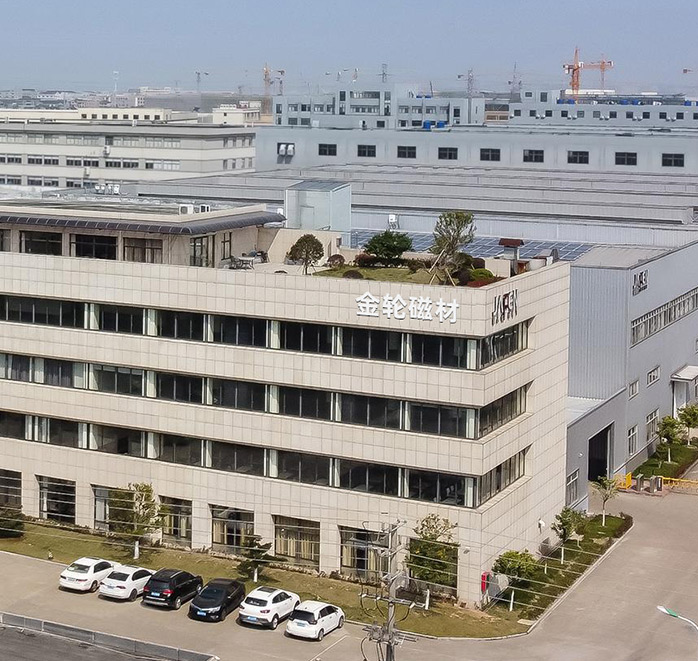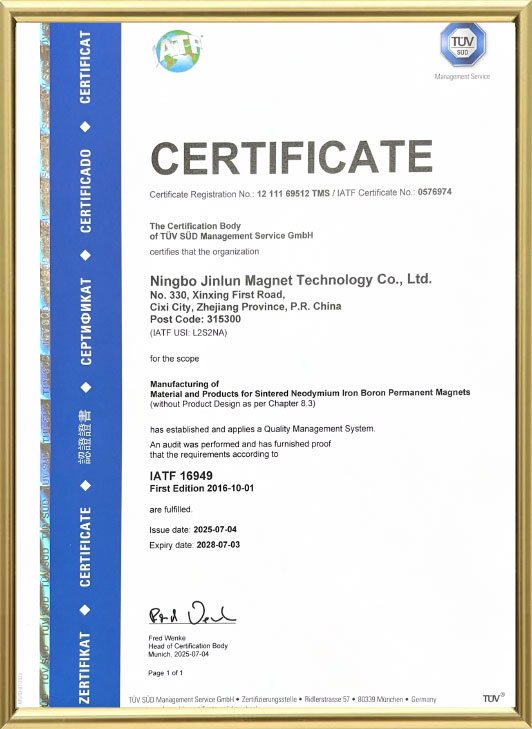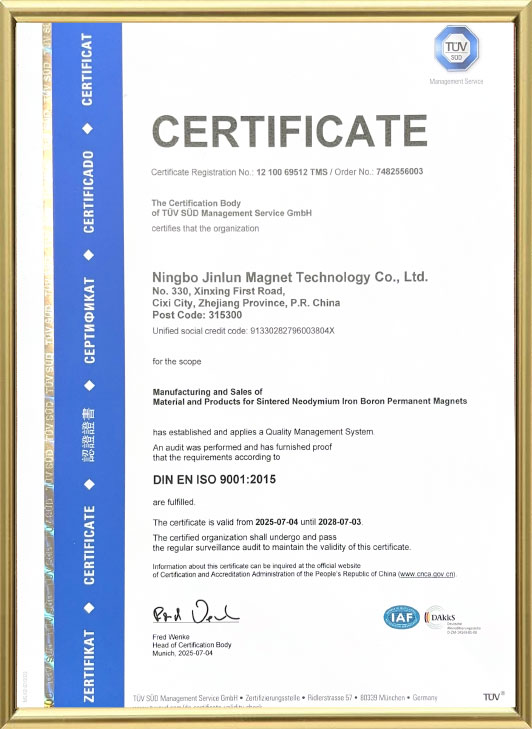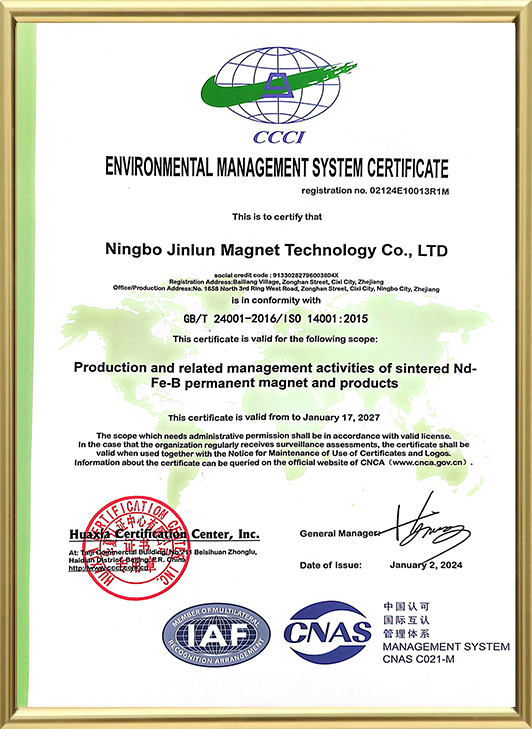I. The Core Positioning and Industry Value of Sintered NdFeB Magnets for the Automotive Field
Sintered NdFeB magnets for automotive field are key components supporting modern automobiles' transition toward electrification, intelligence, and lightweighting. As the highest magnetic energy product among commercially available permanent magnet materials, they offer high magnetic energy product (BH) max, high coercivity (Hcj), and stable magnetic properties. They are used to replace traditional electromagnetic components in key applications such as automotive powertrains, chassis control, and body electronics, significantly reducing vehicle energy consumption and improving power efficiency. They also facilitate the miniaturization and integration of automotive electronic components, making them an indispensable key material for new energy vehicles and high-end fuel-powered vehicles.
From an industry perspective, with the continued increase in global vehicle electrification penetration, the market demand for sintered NdFeB magnets for the automotive field is experiencing explosive growth. Industry data indicates that each new energy vehicle can demand 5-20kg of these magnets (depending on the vehicle model and motor power), 5-10 times that of traditional fuel-powered vehicles. This market size has become a core growth driver for sintered NdFeB magnet applications.
II. Application Scenarios and Performance Requirements of Sintered NdFeB Magnets for Automotive Use
(I) Core Application Scenarios
New energy vehicle drive motors: This is the core application for sintered NdFeB magnets in the automotive industry. In permanent magnet synchronous drive motors, magnets, as core rotor components, must continuously provide a stable magnetic field at high speeds (up to 18,000 rpm) and high temperatures (operating between 80-150°C), enabling efficient energy conversion in the motor. For example, pure electric passenger vehicle drive motors often utilize arc-shaped or trapezoidal sintered NdFeB magnets for automotive use. Multi-pole magnetization and precise alignment reduce magnetic flux leakage losses, boosting motor efficiency to over 95%. Automotive Electronic Assistance Systems: In electronic power steering (EPS) systems, these magnets are used in torque sensors and motor rotors. Their high coercivity (Hcj ≥ 1800 kA/m) ensures accurate steering torque detection in vibration and temperature fluctuations, improving steering controllability. In automotive air conditioning compressors and cooling water pump motors, miniaturized sintered NdFeB magnets (typically 5-15 mm in size) can reduce motor weight and reduce vehicle energy consumption.
Chassis and Safety Systems: In automotive anti-lock braking systems (ABS) and electronic stability programs (ESP), these magnets are used in wheel speed sensors, providing real-time monitoring of wheel speed through stable magnetic field signals with a response time of less than 10 ms. In ultrasonic and millimeter-wave radars used in automated parking systems, these miniaturized magnets optimize the sensor's magnetic field distribution, improving environmental perception accuracy.
(II) Key Performance Requirements
High-Temperature Stability: The ambient temperature of the automotive powertrain and chassis fluctuates widely (-40°C to 150°C). Therefore, sintered NdFeB magnets used in the automotive field must possess low temperature coefficients. Specifically, the remanence temperature coefficient (αBr) must be ≤-0.12%/°C, the intrinsic coercivity temperature coefficient (βHcj) must be ≤-0.6%/°C, and the magnetic performance decay rate must be ≤5% after being held at 150°C for 2 hours to prevent demagnetization caused by high temperatures.
Vibration and Shock Resistance: Driving a vehicle generates continuous vibration (frequency 20-2000Hz, acceleration 10-30G). Therefore, the magnets must possess high mechanical strength, with a bending strength of ≥25MPa and a compressive strength of ≥800MPa. Furthermore, the assembly structure between the magnet and the rotor core must be optimized (e.g., interference fit, adhesive reinforcement) to prevent magnet dislodging or breakage caused by vibration.
Magnetic performance consistency: The magnetic energy product (BH) max and coercive force (Hcj) of sintered NdFeB magnets for automotive applications must exhibit variations within ±3%. Excessive performance variation can cause fluctuations in the drive motor's output torque, increase vehicle jerking, and even shorten the motor's lifespan.
Corrosion resistance: The automotive chassis and engine compartment are exposed to corrosive media such as rain and oil. Surface treatment is required to enhance the magnet's resistance to corrosion. Nickel-copper-nickel three-layer electroplating (thickness ≥ 15μm) or epoxy resin coating (thickness ≥ 30μm) are commonly used. Neutral salt spray testing must be performed for 96 hours with no corrosion. This ensures stable performance throughout the vehicle's lifecycle (typically 8-10 years).
III. Manufacturing Process and Technical Difficulties of Sintered NdFeB Magnets for Automotive Applications
(I) Core Manufacturing Process
High-purity Raw Material Preparation: High-purity rare earth elements (Nd purity ≥99.5%), electrolytic iron (Fe purity ≥99.8%), and ferroboron alloy (B content 19-21%) are precisely mixed and then formed into alloy ingots through vacuum induction melting to prevent impurities (such as oxygen and carbon) from affecting magnetic properties. Ningbo Jinlun Magnet Technology Co., Ltd. strictly controls the purity of raw materials during the manufacturing process, laying the foundation for subsequent magnet performance. Powdering and Magnetic Orientation: The alloy ingot is embrittled using a hydrogen crushing (HD) process and then jet milled to produce a uniform powder of 1.5-3μm with a particle size distribution deviation of ≤10%. During the magnetic orientation stage, a multi-pole directional magnetic field (magnetic field strength ≥1.8T) is used to ensure that the powder magnetic domains are aligned along the direction of the motor rotor's magnetic field, thereby increasing the magnet's magnetic energy product.
Precision Molding and Sintering: For complex shapes such as arcs and trapezoids in automotive magnets, a servo-driven precision press (pressure control accuracy ±1N) is used for compression molding to ensure a uniform green density (≥5.8g/cm³). Sintering is performed in a vacuum furnace at a controlled temperature of 1050-1100°C. Staged holding (1080°C for 4 hours) reduces internal porosity and increases density (≥7.5g/cm³). Post-processing and testing: Precision grinding is performed using a diamond grinding wheel, with dimensional tolerances controlled within ±0.02mm and curvature errors of ≤0.01mm for curved magnets. Surface treatment utilizes automated electroplating or spray coating equipment to ensure uniform coating. Finally, 100% inspection is conducted using a magnetic performance tester (accuracy ±0.5%) and a coordinate measuring machine (accuracy ±0.005mm) to ensure product quality.
(II) Technical Difficulties and Breakthroughs
High-temperature anti-demagnetization technology: The addition of heavy rare earth elements such as dysprosium (Dy) and terbium (Tb) can increase the coercivity of magnets, but this increases costs. The industry is developing "grain boundary diffusion technology," which infiltrates trace amounts of heavy rare earth elements onto the magnet surface. This reduces heavy rare earth usage by 30-50% while ensuring Hcj ≥ 2000kA/m. Ningbo Jinlun Magnetic Materials Technology Co., Ltd. is also continuously investing in research and development in this area to balance performance and cost. Large magnet manufacturing challenges: Magnets used in new energy vehicle drive motors can reach sizes of 50-100mm. Sintering large magnets can easily lead to uneven shrinkage and deformation. By optimizing the sintering temperature curve (heating rate of 5°C/min) and using specialized sintering tooling, deformation of large magnets can be controlled to within 0.1mm.
Batch consistency control: The automotive industry places extremely high demands on batch consistency in magnets. This requires the use of AI-powered visual inspection systems (with an inspection rate of 300 pieces/hour) and online magnetic performance monitoring equipment to ensure 100% inspection of each batch of magnets. Ningbo Jinlun Magnetic Materials Technology Co., Ltd. leverages advanced equipment and testing systems to ensure batch consistency.
IV. Ningbo Jinlun Magnetic Materials Technology Co., Ltd.'s Adaptability to the Automotive Industry
(I) Production Scale and Equipment Advantages
As a company specializing in producing high-performance magnets, Ningbo Jinlun Magnetic Materials Technology Co., Ltd. possesses advanced international permanent magnet production equipment with an annual production capacity of 8,000 tons, capable of meeting the large-scale volume orders required by the automotive industry. Located in Cixi City, on the southern flank of the Yangtze River Delta, the company is situated at the transportation hub of the "Golden Triangle" of Shanghai, Hangzhou, and Ningbo, and is part of the two-hour economic zone centered on Shanghai. This convenient location provides efficient logistics support for automotive customers and shortens delivery cycles.
(II) Technological Innovation and Product Advantages
Focusing on scientific and technological advancements, the company has continuously achieved breakthroughs in the high-temperature stability and magnetic property consistency of sintered NdFeB magnets for automotive applications. Through its independently developed low-heavy rare earth formula, the company achieves a magnetic performance degradation rate of ≤3% at 150°C while maintaining a (BH) max of 400kJ/m³. To meet the automotive industry's demand for rapid iteration, the company has established a 7-day rapid delivery mechanism to quickly respond to customer sample and small-batch order requests, helping automotive customers shorten their R&D cycles.
(III) Green Production and Service Philosophy
The company practices the core concept of "innovation drives quality." Leveraging the environmentally friendly production capacity of its four-star green factory, the company achieves a wastewater reuse rate of over 80% and meets emission standards during production, meeting the automotive industry's stringent environmental requirements for the supply chain. Furthermore, through continuous technology R&D and product upgrades, the company provides customized solutions for automotive customers. For example, for new energy vehicle drive motors, the company can optimize magnet shape and performance parameters based on motor power and speed requirements, providing highly adaptable products.
 EN
EN English
English 中文简体
中文简体 русский
русский Deutsch
Deutsch 日本語
日本語 한국어
한국어



























